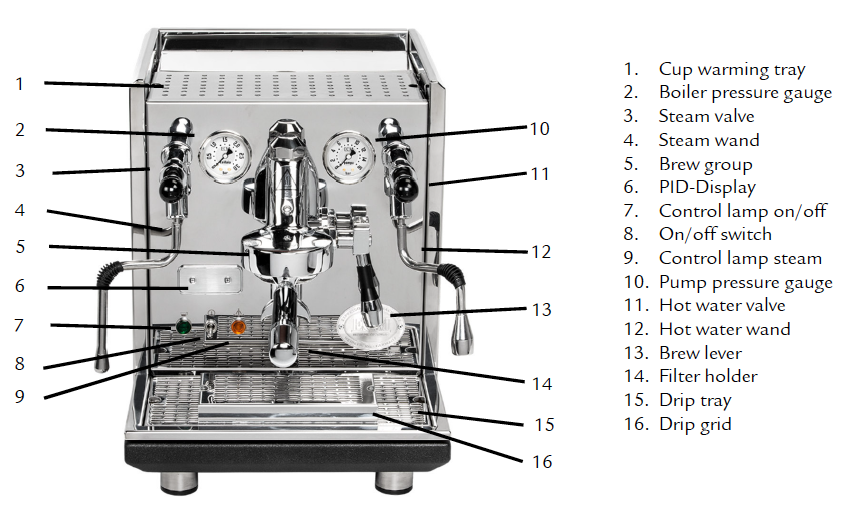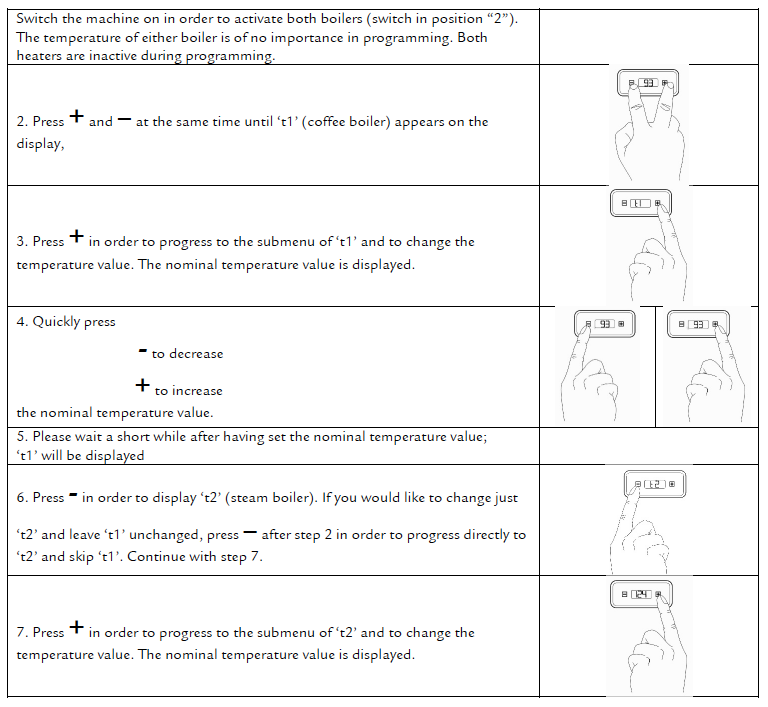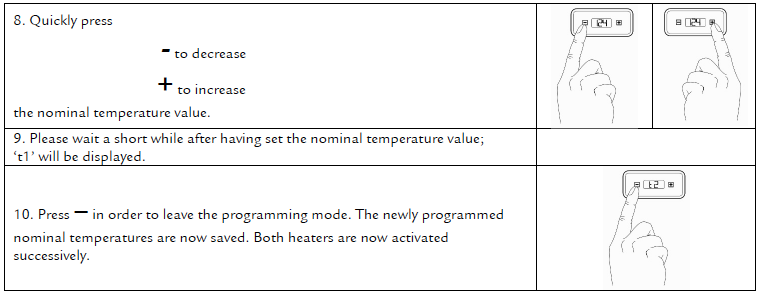ECM Synchronika: User Manual
Set Up Your ECM Synchronika. In this manual, you should find everything you need to operate and maintain your dual boiler, E61 espresso machine.
Please read carefully before using your ECM Synchronika.
If you have any other questions, be sure to contact us.
Setup Video
Machine Diagram

Included Accessories
- 1 Single spouted portafilter
- 1 Double spouted portafilter
- 1 Single filter basket
- 1 Double filter basket
- 1 Stainless steel tamper
- 1 Blind disk for backflushing
- 1 metal hose 1/8” 3/8”
- 1 cleaning brush
- 1 demi-tasse grid
- 1 drainage container
- 1 user manual
Water
Espresso machines have specific requirements when it comes to water. There are two primary considerations: filtration and hardness.
Filtration gets rid of tiny particles, such as sand or rust, in your water. If these particles were allowed to enter your machine they could cause all manner of trouble, particularly by clogging the precise valves and mechanisms in your espresso machine. Almost any water filter will do the job, whether it’s the one built into your fridge, a Brita, or a whole house filter. Ensuring that this filter is replaced in proper time will be important to ensure machine health.
Water hardness is equally important. First, use the water hardness test strips included with your machine to test the water you plan to use with your machine. Ideally, we want a hardness of between 35-85 ppm (parts per million). Hardness refers to the dissolved solids in your water. Common dissolved solids are things like magnesium, calcium, and various forms of sodium. These dissolved solids are what make water, and therefore espresso, taste good. But too much will result in scale buildup in your machine. Scale can cause irreparable damage to your machine by clogging and forming a mineralized layer over the surface of metal parts. The process of descaling is even more damaging, eating away at the machines metal internals. Luckily, scale can be entirely avoided by keeping your water hardness within the recommended TDS range of 35-85 ppm.
There are numerous methods to soften your water should its dissolved solid content be too high.
A note on RO (Reverse Osmosis) or Distilled Water
Taste aside, espresso machines require some mineral content in order to function properly. Their steam boiler fill probes, in particular, use the conductivity of water to detect the water level. With no dissolved solids, they’ll overfill, giving you water instead of steam. You must add some mineral content back in. Our recommendation is Third Wave Water packets which are designed to offer ideal flavor and to be safe for your machine.
Reservoir Solutions
Our first recommendation is an in-reservoir water softening pouch. They’re affordable, last 4-6 months, and are very effective. Using RO water purchased by the gallon in combination with Third Wave Water packets is another great option.
Direct Plumb Solutions
For machines that are plumbed in, we recommend our Water Softening and Filtration kit. It includes everything you’ll need to ensure the water is safe for your machine and delivers the best taste for your espresso.
No matter what solution you pick we recommend testing the water coming from your machine’s group head every few months. City water hardness changes seasonally and softening systems wear out. Routine testing will ensure you keep your machine safe.
First time setup with reservoir
Remove the two wing nuts on the underside of the machine. These hold the pump in place during shipping but will merely amplify pump noise when the machine is in use.
If you are using the machine with its internal reservoir you may simply fill the reservoir with your filtered and softened water, leaving a few inches at the top to prevent spillage. The reservoir is removable. Ensure that you do not spill water on top of the machine when filling, as this may cause electrical damage. When filling the reservoir, ensure that the rubber/plastic water intake line is arranged such that it is fully submerged and touches the bottom of the reservoir. Failure to do so may result in the boilers running dry, causing damage. When inserting the reservoir, ensure that the face of the reservoir with the magnetic water level float housing is facing the front of the machine and that the float is in place.
First time setup with water line
Remove the two wing nuts on the underside of the machine. These hold the pump in place during shipping but will merely amplify pump noise when the machine is in use.
Before connecting the water line, turn the water source valve found on the underside of the machine toward the back 180°, such that it points away from the water inlet. Next, flip the water source switch behind the drip tray to the direct plumb setting, which looks like a water faucet. Fasten the braided line included with the machine to the water inlet on the underside of the machine until hand tight, then give it a quarter turn with a wrench. Open your water line and check for leaks at all connection points.
Turn the machine on and lift the brew lever to run water through the group head for 10 seconds before pulling shots to ensure the system is fully saturated.
Programming the PID
During normal operation, the temperatures of the coffee boiler (t1, left dot on the display) and the steam boiler (t2, right dot on the display) are indicated alternately. The controls are factory pre-set so that both boilers are heated consecutively, whereby the coffee boiler (t1) has priority. This means that the steam boiler (t2) is activated only after the programmed temperature of the coffee boiler has been reached.


Turn off PID display feature:
There is the option to turn the PID display off: Press the + button until the display turns off. A dot will appear on the display, which indicates that the machine is still turned on. The display will be turned on again by pressing the +button once more.
Programming the group cleaning mode:
With the Synchronika you have the option to program a reminder for next the group cleaning at the PID display. The machine is set to 0 at the time of delivery. Please take the following steps to program the cleaning reminder: Press + and – at the same time and “t1” will appear on the display. Press the – button until you reach “CLn”. Now you can carry out the programming in steps of 10 by pressing + and -. In order to leave the programming mode, wait until “CLn” appears and then press the – button. Alternatively, the temperature indication appears automatically after 15 seconds. For example, if you have programmed 90, then you will be prompted with a “CLn” on the display to clean the brew group after 90 brewing cycles. Clean the brew group in such a manner that the brew group is flushed with at least 10 brewing cycles until the temperature indication re-appears on the display (see 7.2 Brew group cleaning, page 28).
We recommend a cleaning of the brew group after about 90 to 140 brewing cycles.
Technical Details
For a complete list of technical details, please see the spec table on our product page.
Now you're ready to start pulling shots! Check out our Espresso 101 section to learn about steaming milk, latte art, our suggested starter espresso recipe, grinder dial-in tips and much more.
Looking for Help with Flow Control?
Helpful Links
- Espresso 101
- More on Water and Setup
- Clive Blog
- Espresso Machine Cleaning & Maintenance
- Manufacturer Manual in PDF
Still have questions? Reach out to our coffee experts and technicians.